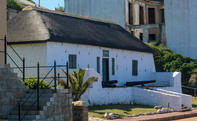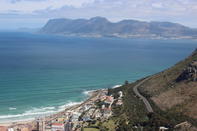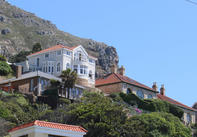Exquisitely Faded Resort Town
Muizenberg is an exquisitely faded resort town with a long history. It once served as a cattle post (established in the 1670s by the Dutch East India Company at nearby Zandvlei), a winter anchorage for company ships and a military outpost.

It all began in 1673, when Sergeant Wynand Willem Muijs set up a garrison in the shade of what has become known as Muizenberg Mountain. From this position, he was ordered to patrol the False Bay coastline for enemies of the Dutch East India Company, and to stop the farmers of Constantia from trading illegally with rogue ships in False Bay.
All in all, it was a cushy job and nothing much went on for the next 120 years. One of the original buildings of Muys’ garrison still stands, reputedly the oldest habitable building in False Bay, and has been turned into De Post Huys Museum. Then, False Bay suddenly hit the headlines in 1795, when the Battle of Muizenberg broke out. This was a brief skirmish between the Dutch and the British, and it ushered in the first, abortive British occupation of the Cape.
Battle of Muizenberg

More of a skirmish than a battle, this event changed the history of South Africa and is the reason we do not speak French. It was, in fact, part of the ongoing rivalry between Britain and its archenemy, France, both powers wanting control of the vital sea route to the East.
In July 1795, just as revolution spread from France to Holland, a small British force arrived in Simon's Town with the intention of securing the Cape ahead of the French (Holland's ally). With foot soldiers marching towards the small Dutch fort at the base of Muizenberg, four warships moved up alongside. Broadsides from the ships on 7 August led to the Dutch abandoning their little base and retreating to behind Zandvlei (the current suburb of Retreat).
But it was to be another month before a much larger British force arrived, driving the Dutch back to Wynberg Hill until they finally surrendered their fledgeling colony. Stone ruins on Main Road, complete with an information board, mark the spot where the Dutch made their futile stand, while higher up, just below the shark spotters' lookout on Boyes Drive, is another small Dutch fortification.
British Arrival

Once the British had arrived for good, in 1806, their penchant for picturesque seaside resorts found its ideal expression along the beautiful beach at Muizenberg and, over the years, the town grew as a holiday annexe to Cape Town.
Then, in 1899, Cecil Rhodes bought a little cottage on the edge of Muizenberg, and gave the place his implicit stamp of approval. The flood gates opened, and all manner of well-to-do folk moved in. Many of their stately mansions can still be seen standing proudly on the ‘Millionaires Mile’, running from Muizenberg to along the main road.
But everything started to change when the old Queen died in 1901. The Victorian Age was coming to a shuddering end, and Victoria’s successor, King Edward, was fated to preside over the final heyday of the British Empire. When the First World War erupted in 1914, the death knell rang for the Imperial system, and the British Motherland went into terminal decline. The golden age of Britain was officially over.
Cultural Treasures
Among the town’s cultural treasures is the Natale Labia Museum, a beautiful dressed-stone mansion built in the 1930s for Prince Natale Labia and Princess Ida Labia. It now serves as a satellite museum of the South African National Gallery. De Post Huys, built in 1673 by the Dutch East India Company as a signal house and a small fort, is one of the oldest European-built houses in South Africa.
Also of interest is Rhodes' Cottage, an unassuming thatched home where Cecil John Rhodes died in 1902. If you don’t feel like walking, take the train which runs along the coast from Muizenberg to Simonstown. It starts at Muizenberg’s beautiful red brick and sandstone station, built in 1912, and stops at each of the villages along the coast.